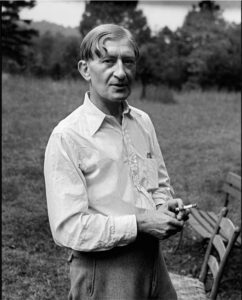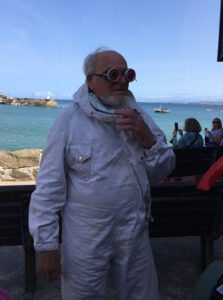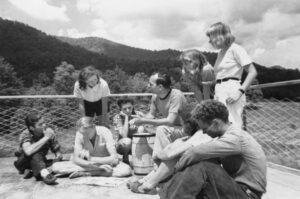
Ken Turner. September 2020
Ken Turner
I want to change the world, I fail all the time
Alfredo Jarr

Credit: Barbara Morgan/Getty Images
It’s funny when you create an image on a canvas and it looks back at you. Funny in the sense of being something other, a thing of difference and strangeness to one’s own idea of life, how we see and think. It’s an imaginative leap into the idea of life where we have never been before. And, it happens on canvas.
I have coined the word imaginativity as a means to differentiate between creativity and imagination. The reason for doing so is to stop using the word ‘creativity’, because it has become a politically motivated term which leads to stagnant thoughts. Being creative is comparatively easy. It’s often just a slight shift in perception, and we define it to be an example of a raised level of interpretation, or as an expression of the feelings surrounding an insight or understanding attained about the human condition. It suggests a deeper, less normative way of thinking. But too often this is not so. As humans we are fallible creatures. We make mistakes. What humans have been doing recently is beyond comprehension. You could put it down to lack of imagination, but ordinarily it’s a lack of foresight. And, through a lack of imagination but no lack of creativity. We hardly ever learn from mistakes.
Some years ago, a symposium, Revisiting Black Mountain College: Cross-Disciplinary Experiments and Their Potential for Democratization (25–27 May 2018), was organized by Professor Dorothee Richter in conjunction with an exhibition and event programme initiated by the Zurich University of the Arts. Many professional thinkers and artists got together to re-examine the workings of the college in its cross-disciplinary experiments and conviviality in method and approach.
Between 1933 and 1957, Black Mountain College in Asheville, North Carolina, became this amazing cauldron in which new experiments and combinations of disciplines in arts, music, theatre and dance took place. Many now-illustrious names have been passed down into our confused minds as artists, and to my mind this newness was a playfulness coming out of conviviality, where the imagination could function in its true nature as ‘imaginativity’. A partial list of artists includes Willem and Elaine de Kooning, Robert Rauschenberg, Josef and Anni Albers, Jacob Lawrence, Merce Cunningham, John Cage, Cy Twombly, Kenneth Noland, Franz Kline, Arthur Penn, Buckminster Fuller, Charles Olson. There were many others. They all took part in everyday activities in gardening, cooking, building, and eating together as well as their own interdisciplinary work.
In imaginativity there are no boundaries either of action or thought. In a college like Black Mountain, ideas became action, became a way to enter new territories of image making, and had to happen because what mattered was the doing. Imaginative action. Play plus conviviality was an important element. A play within the play of the work and the play of the imagination; without play no imagination is possible. Play is the essential part of doing.
Along with the founder of Black Mountain College, John Andrew Rice, John Dewey’s ideas on education were part of the college’s philosophy; his ideas of doing and thinking were integral to the teaching environment. These methods have been handed down and were part of the upheaval of the 1960s in Europe, the UK and North America. But did they go anywhere? Of course not, we don’t learn from experience. The recent example of the closure of the humanities in universities is but one example. I’m a bit tired of hearing about, or expressions of horror at, the continuing deprivations in the destruction of equality and opportunity in the arts. Or to hear again the arguments around the heavy weight of commodity culture. As artists we require something more: not to reiterate the modern strictures time and time again. On the other hand, perhaps the artists of the art world are but a subculture of dealers and collectors. They then construct price mountains that only succeed by destroying any semblance of the ethical concerns that are essential to the arts. What a long way this is from Black Mountain College’s ethos of self-defined responsibility, without authority or hierarchy, and its sense of community and value in the experimental.
A while ago I played out an interesting series of protests against the destruction of sensibilities by the media, internet and the commonality of a ‘status quo’ in culture. I counteracted by establishing a performance art approach through ‘Codswallop’ (2017). A method stolen from Diogenes, the Greek philosopher living in 450 BC who dragged a codfish through the streets of Athens in answer to ‘What is philosophy’? What was important at the time was to make clear how the majority of people weren’t thinking hard enough about how the economic structuring of culture was coming from the institutionalisation of the establishment. To me it was a case of the blind leading the blind. Imaginativity is required from all sections of society, and, in particular, the understanding of how the internet mediates the art world.
The way the media and associated technologies are generally discussed as a global extension of knowledge is one of the blind spots in communication. Blind, that is, to the medium itself and its effects. We are back to Marshall McLuhan and ‘the medium is the message’. A. N. Whitehead also said “the major advances in civilisation are processes that all but wreck the societies in which they occur”. And that is the point: the way the internet runs through society, penetrating our nerve endings of existence, can be likened to any medium as a form of control. It has become an educational tool in the way strategic economies are engineered. Precisely, that is, the way by which people are kept in place. It has become a structured inequality, necessary to tax systems and nation state hierachy. Nothing more than a new ‘slavery law’ of our economics.
Looking at the canvas again, the real question is where is the evidence of the artist’s vision? Are hand-controlled expressions of images proposing new ways of thinking, anywhere on planet Earth?
This question has obviously a deeply significant relation to how we think. As a world battling climate change, it moves us as humans to rethink humanity’s purpose. It becomes fundamental to consider the future. However, I feel tired again, tired when I hear broadcasts through the BBC and other channels proposing changes to inequality by promoting wealth creation and equality of opportunity. I haven’t seen or heard of artists being asked for their ideas on rethinking.

Should we not think of taking a new look at art schools? Put them back into autonomous organisations. Re-establish art schools as ‘schools of imaginativity’. Subsuming art schools into universities was a deleterious move. Departments of art and cultures saw a turn to an unimaginative display of artefacts in place of art and a proliferation of media-type works of art without an understanding of the medium itself. It was only done for elevated access to more grants. And the rise of ‘critical writing’ brings further damage as a distortion of imaginative thinking. Distortion to such an extent that ideas of chaos and conscience in methods were subjected to pressures from stultifying thought processes of unforgivable, academic narrowness and peer review of what philosophy means. Committees cannot make art or think artists into being.
This to me is a dangerous situation. We can only hope that artists somewhere exist outside the institutions who can bring some sense of ‘imaginativity’ as a state of consciousness necessary to culture in general. Consciousness as part of imaginativity is in itself not an easy state of mind to examine (though consciousness itself is contained in the idea of imaginativity). Following our argument of rethinking, Kant held the idea that art was autonomous, that a painting continued to exist outside human audiences. If the aesthetic was only brought into action when a spectator was in evidence then what of an image in its imprisoned state outside human activities? Can we say that it doesn’t exist? How absurd is that.
Imagine a gallery of paintings, just hanging there, waiting for a spectator. If the spectator doesn’t arrive, what then? The images need to compose themselves, adjust and in readjusting to speak across the space of the gallery, to communicate, together. If this happens, a format of sensual exchange will begin to fill the space, reaching fever pitch in desperation for an audience. In this condition of estrangement, something else happens. Through the excitement of an arts interchange, a certain sense of absurdity spreads over the scene. Painted images communicate across image to image in a state of imaginativity, gesturing wildly, asking each other, where are the spectators to this important exchange of feelings, they are missing something of importance concerning humanity and humanity is not here! “We are the symbols of life, we form the safeguard to distortions of culture. Our presence is more powerful than any other media”. Poor humanity, these humans know not what they construct when they leave art to fend for itself. What happens then? Strange creatures move in to devour ideas of culture, obscuring visions and imaginative ideas. And, more importantly, voraciously working toward the death of any feeling and philosophical intervention; distortion within the painting’s depths of sensuality, pulling them down to the level of their own greed, as they bargain and haggle; gloating their way through mangled perceptions. Is this just a fantasy? How can a gallery without an audience function vitally as a cultural experience for all peoples? Of course, my mistake, there is an audience after all, it’s the ‘culture industry’.
Let’s move on to something more interesting than the status quo. Philosophy moves as slowly as art when it comes to sensing what reality means. For me reality is when a painting becomes more than it appears at first sight, even when the paint is still fresh. As I described at the outset, the strangeness of an image exists as if outside one’s ordinariness. It is becoming part of the world as a new thing or object, just there, now existing, certain in its unassailability of composure. This is how imaginativity works. And my point now is to emphasise this by referring to Graham Harman and his ideas on new realities, and recently his ideas on what art does, what happens when art and object are observed as coming together.

In the first place we live in a world composed of humans and objects. The objects under consideration here are paintings. In living with them we have to be able to ‘understand’ them, or should be able to do so. To know what they are ‘about’, or ‘on about’- it’s not a matter of knowing what we know but knowing what we don’t know. In this quandary we ask, communicate or ponder on art as a sensual object. Not forgetting that we function as a ‘sensual human object’ also. Applying the sensualities of both human and painting as a mix of qualities thus becomes an equation of possibilities. Harman speaks of architecture as a living space that we occupy gradually as the space of the form reveals itself. Moving through it, experiencing the space and form dramatically. This is what Harman says of objects, that they are theatrical, and it’s this nature of the object, being architecture, painting or glass bottle or whatever that we as humans conjoin with, theatrically. This amounts to us humans meeting the painting experience within a third object. As Harman indicates, there is this space above or in and around us, painting and human. To me, this is the emotional zone of feeling. Also, we encounter the painting at different times, morning, or at dusk and in different lights and environments. Humans also change moods, temperaments and digestive movements. So, the conjoining of us as objects changes, and we get to know one another in different moods, means and ways. Needless to say, it takes time and the world is not suited to such time realizations. Just witness any public art gallery and it becomes obvious that citizens are virtually out of step with the art of looking.
However, this is not all, we are not solving the problem of looking through the meeting of object and human in our different sensibilities. Heidegger steps in here with his analysis on tools. We only begin to know the tool when it’s broken, and in knowing it, it retreats from us. When we encounter a painting and begin to sense its qualities through our own emotional state, even with the realization that we now may have, in a third theatrical space, we cannot begin to fully get to grips with the painting. The work is in constant retreat. And perhaps we can never know completely its meaning. We can experience the different nuances through textures, colours, tonal changes and compositional dynamics, but always something eludes us. But that is not a disadvantage, quite the reverse, it’s exhilarating because we can never stop, never know the whole ‘story’, as it were. And, we can continue to ‘live’ with the painting in imaginativity.
Volume 35 no 2 November / December 2020


That’s one way of looking at things, nicely done.
Please leave your name. (Ed.)
How has art or “art” ever changed the world? It certainly has wished to and perhaps aspired to but actually changing the world – no never. That is not to say it should not stop to either suggest what ever it has to perceive or interpret or organize what ever it means with in the realm of art. But art as a change agent of history? Never.
Everything that happens is changing the world and art is part of that.